The new Loop circular shopping platform—unveiled today at the World Economic Forum in Davos—enables consumers to buy their favorite products in durable, not disposable, packaging. Supported by top brand owners such as Nestlé, Coca Cola, Unilever and Procter & Gamble, Loop relies on premium and long-lasting packaging that is designed for multiple reuse before ultimately being recycled.
Loop is a business venture of recycling/upcycling and waste management company TerraCycle. Taking an audacious first step in solving what he sees as a global waste crisis that has been growing more than half a century, TerraCycle founder and CEO Tom Szaky recreates the “21st century milkman” by collaborating with more than 20 partners that represent more than 40 brands, global retailers, and package delivery and waste management companies. [Watch the press conference of the announcement in Davos here. Read the official announcement press release here.]
On top of massive environmental benefits as determined by lifecycle assessments, Loop elevates the consumer’s experience with the brand and its high-end reusable packaging. The shopping platform will launch this spring in two pilot markets—Paris and New York [UPDATED 6-6-19: Loop reusable packaging shopping platform launches in the U.S.]—with additional expansion underway.
In an exclusive interview (see video at the top of this page), Szaky…
• Tells us how Loop was developed and why;
• Identifies the root causes of waste;
• Explains how Loop challenges the idea of who “owns” product packaging—from consumer back to the brand;
• Outlines the price-value equation for consumers, brands and retailers; and
• Shares Loop’s additional growth plans, including expansion in the United Kingdom and Japan.
The 43-minute video above showcases several brand’s Loop packages (some throughout, but most starting at 40:31) and also identifies the 20+ partners involved so far.
Nestlé is one of the initial partners. Tommy See Tho, packaging manager at the Nestlé Product Technology Center for Ice Cream, has been working on the project from the beginning and designed the Loop packaging for five Haagen-Dazs products: non-dairy options Chocolate Salted Fudge, Coconut Caramel and Mocha Cookie; as well as traditional favorites Vanilla and Strawberry.
Why participate in Loop? See Tho explains, “Nestlé is working to reduce its environmental impact in all its business operations, while also finding innovative new ways to connect with and provide great products to consumers. As part of these efforts, Nestlé is proud to join TerraCycle as a founding partner of Loop.”
It took packaging specialists from Nestlé’s Product Technology Center for Ice Cream in Bakersfield, CA, one year to revolutionize the Häagen-Dazs pint to bring the brand to the Loop platform with a reusable container. See Tho tells us that the package—etched with the familiar Häagen-Dazs brand tapestry and design—is made of stainless steel and features a twist-off top. The metal canister keeps ice cream cold much longer than traditional paper-based ice cream packaging.
“When creating more sustainable packaging, we also wanted to prioritize the consumer experience,” See Tho says. “For example, when opened, the package is designed so ice cream melts more quickly at the top to provide the perfect texture for enjoyment. The container is double-walled which keeps the ice cream cold but also makes the outside of the canister pleasant to hold. The metal lid is easy to open—it juts out so there’s a higher surface area to hold and twist. And, we rounded the corners of the container to make it easy to scoop and enjoy.”
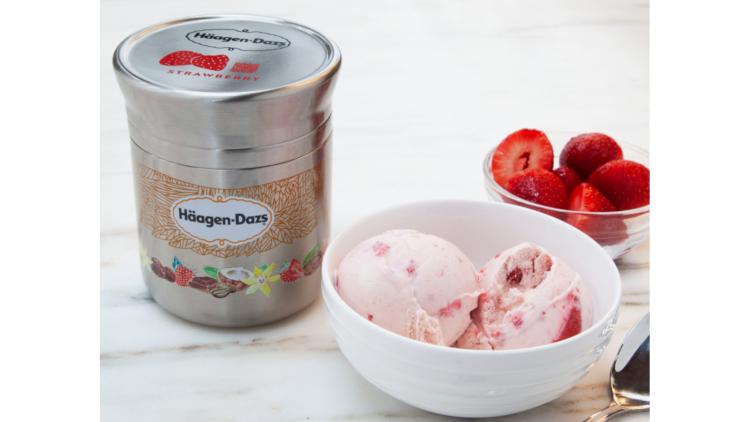
The Häagen-Dazs double-wall stainless steel container keeps ice cream cold for a long time outside the freezer yet is comfortable to hold.
See Tho’s colleague, Walter Peterson, who is packaging sustainability manager at Nestlé USA, spoke at WestPack 2019 (Feb. 5-7; Anaheim, CA) at 1:00 - 1:55 p.m. on Tues., Feb. 5. In his presentation “How Nestlé Is Innovating Its Way to 100% Recyclable or Reusable Packaging,” Peterson talked about Loop and about the company’s ambitious goal of moving to 100% recyclable or reusable packaging by 2025.
So how does Loop work?
In addition to the high-level interview with Szaky in the video above, multiple people at TerraCycle provide more details about this ground-breaking development.
Have consumers experienced this concept? If so, what was their reaction?
TerraCycle: We’ve been running Consumer Insight Testing over the last year (12 months in Greater NYC and six months in Greater Paris). The majority of consumers who have tested Loop like the platform and name three major hooks in varying orders: convenience, premium products and no waste.
Which brands are participating?
TerraCycle: These are the initial partners. However, partners are continually being added.
Procter & Gamble, Nestlé, PepsiCo, Unilever, Mars Petcare, The Clorox Co., The Body Shop, Coca-Cola European Partners, Mondelēz Intl., Danone, Jacobs Douwe Egberts, Pladis, Lesieur, BIC, Beiersdorf, People Against Dirty, Nature’s Path, Thousand Fell, Greenhouse, Grilliance, Burlap & Barrel Single Origin Spices, Cozie and Preserve; retailer Carrefour; primary logistics and transportation company UPS and sustainable resource management company Suez.
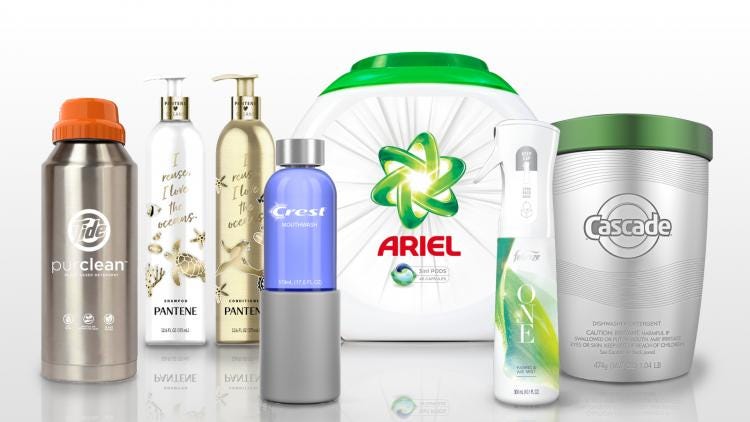
Procter & Gamble has created reusable, refillable packaging for 11 of its most popular products as part of a new effort that aims to change the world’s reliance on single-use packaging and disposable waste. (Photo: Business Wire)
How can other brands get involved?
TerraCycle: Loop participants must apply and be accepted into the platform. Brands interested in getting involved are welcome to contact the Loop Business Development team. Please email [email protected].
Are there product categories better or less suited to participating in Loop and why?
TerraCycle: Any product category can be integrated into Loop. Currently Loop operations are flexible enough to handle ambient, chilled and frozen supply chains, as well as [temperature-]control items.
You say some packaging is being “scientifically” designed. Explain more, please.
TerraCycle: For example, Nestlé partnered with TerraCycle to create brand-new packaging for its Haagen-Dazs brand that will keep ice cream frozen without the use of conventional refrigeration for an extended period of time—which is essential for doorstep delivery. The Loop Tote is also scientifically designed and, coupled with the Haagen-Dazs package, it enables the ice cream to stay frozen longer.
Who designs the packaging? Does each brand create its own packaging or is there a Loop or third-party design firm involved?
TerraCycle: Each brand is responsible for designing its own packaging. Loop acts as a consultant in supporting each brand’s packaging innovation.
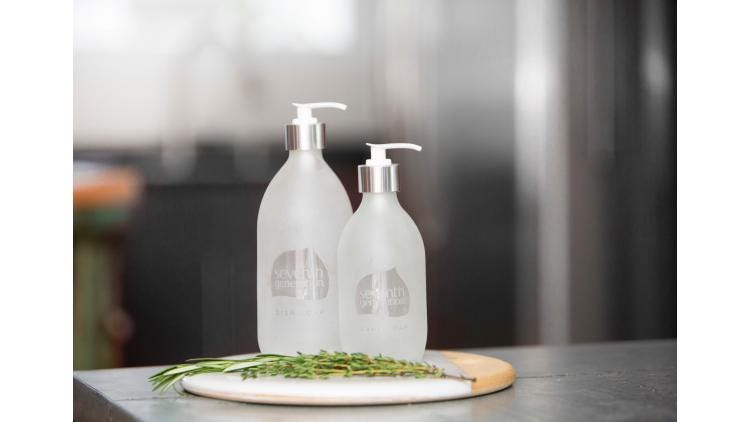
Durable graphics on Seventh Generation's soup pumps withstand aggressive cleaning between fills.
How does the package design take into consideration user experience or package functionality, as well as where the product is used or stored?
TerraCycle: We encourage each Loop brand to design the most premium, durable, innovative packages to give the consumer the best experience possible.
Do different brands (of shampoo, for example) all use the same style package? How do brands maintain their image/equity/branding?
TerraCycle: As of now, there is only one brand per category. Packaging style is up to the brand and Loop encourages them to be innovative and creative.
Are the packages direct-printed or do they have labels? If labels, are they durable, too, or are they easy to remove and reapply?
TerraCycle: All packages are intended to be zero waste. Loop advises brands to utilize etching and printing.
Are all the packages rigid or is flexible packaging an option? Are flexible packages durable enough to be cleaned and reused?
TerraCycle: All packaging in Loop is durable and all packaging material is agnostic. Brands/partners can use the material of its choosing provided it’s durable. Flexibility doesn’t necessarily equate to bad—that is, silicone is flexible but hyper durable.
How many minimum trips does the packaging have to withstand? How is it determined/tested that the package will, indeed, survive that many uses/reuses?
TerraCycle: Packages are designed with durability in mind. The lifespan of each package will vary depending on each. There are variables in lifespan including aesthetics that can cause a package to be taken out of circulation and recycled. Loop partners use materials that can be recycled and turned back into a future pack at end of life.
Can packs at end of life be recycled into other products, following the TerraCycle model? Or does it have to be package-to-package recycling only?
TerraCycle: The concept of the model is there is no waste. So, anything generated in the platform has a recycling solution. Some things will not be package-to-package, but all will be recycled.
Just how durable are these packages? Scuffs and other visual defects could be a deterrent to some consumers in the whole reuse consumption concept.
TerraCycle: Durability varies by package and consumers participating in Loop are aware the packaging is reused. It is determined by the brand when the package is taken out of circulation and recycled. The exact number of times is dependent on the specific packaging.
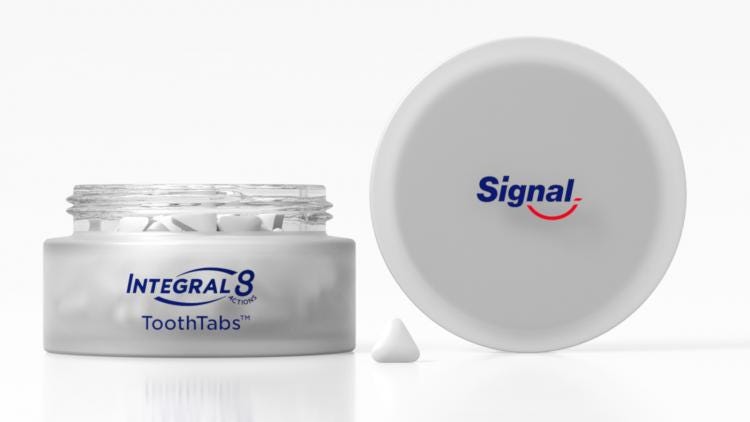
Signal innovated the product, a single dose of toothpaste in a "tab," as well as creating a reusable jar.
If consumers return the package for refilling/reuse once it’s empty, won’t they run out of product? Or is the concept to create a pool of packages that are reused for/by different consumers? For that matter, is the concept to create a pool of packages that are used/reused for/by different brands?
TerraCycle: Loop brings to market a new subscription model: subscription based on consumption. Since the empty packages are returned to Loop, we are aware of consumers’ consumption rates and replenish only when they have finished the product. The target for turnaround is two days.
Will Loop use parcel carriers for product distribution or is it all direct delivery by Loop?
TerraCycle: In the United States, Loop has partnered with UPS for its delivery.
What about Paris?
TerraCycle: In Paris we have a delivery partner, but UPS is not the primary delivery partner.
Will Loop be doing the fulfillment/shipping of these products or will the brands have that responsibility?
TerraCycle: All Loop products are stored at the Loop warehouse and sent to the consumer from the Loop warehouse. Loop receives empty packages back from consumers, sorts them, cleans them and returns the clean packages to the brands to be refilled.
How many Loop facilities are there and where are they located?
TerraCycle: There are four Loop facilities: a warehouse in central NJ and a cleaning facility in Eastern PA; and a warehouse in the outskirts of Paris and a cleaning facility in Eastern France.
Who pays for shipping? Anything available like the Amazon Prime example of a membership with free shipping?
TerraCycle: The consumer pays for shipping. However, the more product ordered—and the more full each Tote—the less the cost of shipping.
Who will be doing the cleaning and refilling?
TerraCycle: All packaging is cleaned by Loop’s proprietary cleaning system.
Was or is there a need for any new type of packaging machinery to handle the cleaning, handling or refilling?
TerraCycle: Yes, there was a need to develop new packaging machinery to handle the cleaning. The cleaning system is state-of-the-art and designed specifically for Loop packaging. Loop has designed cleaning processes specifically for Loop products. All packaging is sanitized and adheres to strict brand audits.
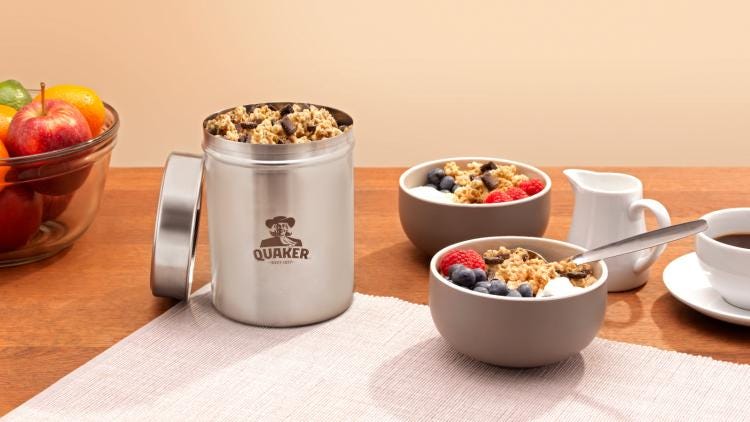
PepsiCo's Quaker cereal replaces the typical and often-criticized bag-in-box with a steel canister that is easy to open and pour from—and then can be resealed to keep the product fresh.
For any food or beverage products, how will brands ensure that packages are properly cleaned before refilling? How are they able to guarantee safety? What more can you tell us about the custom cleaning technologies developed by Loop scientists?
TerraCycle: Loop’s state-of the-art cleaning systems have been scientifically developed to sanitize each item. The cleaning process was built in response to the stringent quality assurance controls of each of the brand partners. The system is proprietary, so we can’t provide more information.
Loop partners with some of the world’s biggest brands and those brands have very stringent standards to which Loop adheres. All packages inside the tote are sealed and must pass strict quality assurance. There will also be a tamper-evident seal on the Loop Tote to ensure the Loop Tote was not tampered with before opening.
Will this be for any consumer-initiated sales or only for recurring/subscription purchases?
TerraCycle: Each product has a one-time purchase and subscription option.
What more can you tell me about the “groundbreaking technology” used for recycling the packaging?
TerraCycle: Here are a few examples of some of the items being recycled for the first time through new and innovative technology.
• Gillette/Venus Razor Blades: Through Loop, razor blades will be recyclable for the first time in France.
• Always Pads: Through Loop, panty liners and pads will be recyclable for the first time in France.
• Pampers: Through Loop, used baby diapers will be recyclable for the first time in France.
• Oral-B Electric Toothbrush and CLIC Manual Toothbrush: Loop will collect used toothbrush heads and recycle them.
About the Author(s)
You May Also Like




